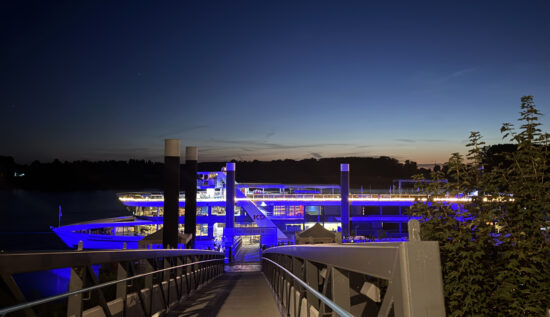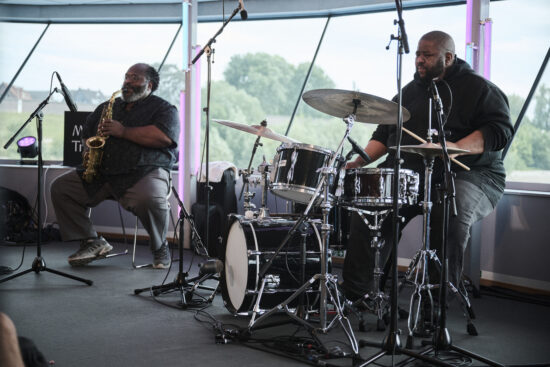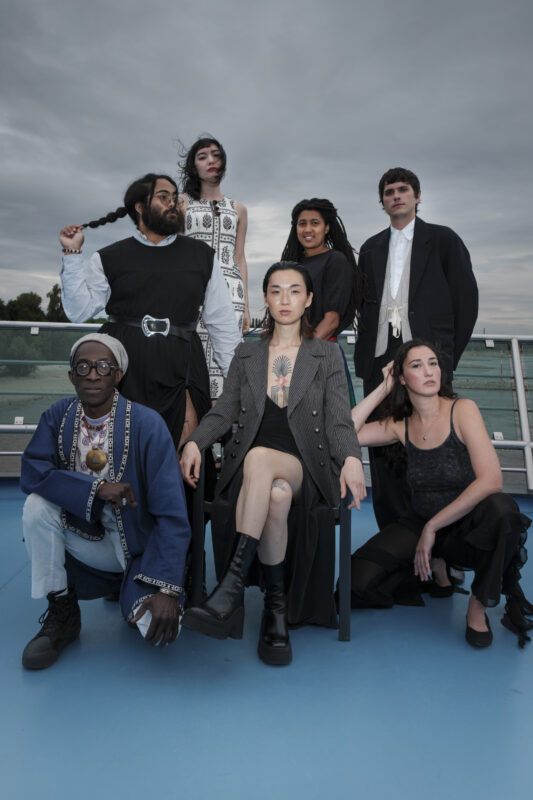The Monheim Triennale, in Monheim am Rhein, Germany, is no ordinary jazz festival. First, it only happens every three years. The inaugural edition was in 2022. Triennale II was July 2-6, 2025.
Second, the programming is unusual. Sixteen artists are chosen to develop exclusive “Signature Projects.” A year before the festival, they gather in Monheim for a “prequel,” where they all meet, often for the first time, and present collaborative performances. The idea is that they will find inspiration for the Signature Projects that each will present the following year.
Third, its primary setting is MS RheinFantasie, a large riverboat moored on a dock on the Rhein River. Shows happened on the boat’s main stage amidships, and in a smaller space in the boat’s bow. When the music stopped you could climb to the upper deck, sip German pils and watch barges float down the river.

Fourth, it is not really a jazz festival, according to its artistic director, Reiner Michalke. He ran a major German jazz festival, Moers, for 11 years. He now believes that “jazz is music of the 20th century.” He has said, “We don’t need another jazz festival.” He conceives the Triennale as an experience that includes and perhaps even starts with jazz, but then expands. Michalke seeks out musicians “whose work crosses borders — cultural, disciplinary and technological.” In a talk at the beginning of the festival, he said, “It’s not about categories. It’s a journey. It’s all about surprise. That’s why we have no working bands.”
The Triennale is easy to navigate. Monheim am Rhein is a lovely quiet town in west central Germany, exactly between the larger cities of Düsseldorf and Cologne. Life looks good there. In addition to the boat, the festival put music in Sojus 7, a cultural center with an industrial look, and in two pretty old churches, Altstadtkirche and Marienkapelle. Everything is walking distance.
One challenge was the packed schedule. In a five-day program, there were 16 Signature Projects and over 30 additional events. Most of the latter were called “fringe” concerts. They drew upon some of the 100 artists who had traveled to Monheim. Many were solo, duo or trio performances. There were days that included 13 separate events. There was also a fascinating full-length documentary film by Mika Kaurismäki, Every Note You Play. It was shot during the prequel in 2024. The Triennale is, among many other things, a marathon. By necessity, this report is selective.
There was less jazz in 2025 than in 2022. But some of it was strong enough to make you question Michalke’s statement that jazz is 20th-century music.

The Peter Evans Signature Project
What Peter Evans contributed to the 2025 program was formidable 21st-century music that could only be called jazz. Evans can be a hermetic artist. He has been known to perform solo trumpet concerts in which he rarely “plays” his instrument in any “normal” sense. But in Monheim his radicalism was an asset that added intrigue to his larger ensemble material. His first appearance was a workshop event with a nonet featuring musicians from Monheim. The music, composed by members of the band, was adventurous but carefully organized. It made room for Evans’s trumpet solos like fractured fanfares.
Evans’s Signature Project was titled “Being & Becoming + Voices.” It was so large that it had to be performed in two segments, on successive nights in Sojus 7. The band was a septet but sounded larger. Evans said that the piece used the structure of a Bach cantata, but it felt more like a sound storm. Joel Ross’s vibes rang and clanged at the center of the ensemble. Tyshawn Sorey was on drums, at his most volcanic. Three singers threatened to raise the roof of Sojus 7: Sofia Jernberg, Mazz Swift (who doubled on violin) and Alice Teyssier (who doubled on flute). You might think that a septet with violin and flute would be relatively quiet, but you’d be wrong. The music was a vast array of disparate parts, crashing into one another. As the singers screamed and Evans fired furious volleys, you feared that the piece would fly apart. (Those sitting in the front rows were pinned back in their chairs.)
But this wild cantata always finally cohered, and even found peace, before it subsided. The Monheim Triennale is an undertaking that explicitly seeks the transcendent. When “Being & Becoming” was over, the audience knew it had been present for something extraordinary.
The Darius Jones-Joel Ross Experience
As part of the fringe program, Darius Jones and Joel Ross performed remarkable back-to-back solo recitals in Marienkapelle. Jones is an outcat, but his concert was not entirely noisy. In the beginning, his long calls climbed into his alto saxophone’s upper register and beyond and became shattering shrieks. But soon his flurries began to settle into a haunting melody. It became clear that Jones was playing a spiritual. He offered its solemn refrains into the rapt silence of the small chapel. Afterward, Jones said he had played “No More My Lord,” a prison work song sung by Henry Jimpson Wallace and recorded by Alan Lomax in 1948 at the Parchman Farm penitentiary in Mississippi.
When Ross’s concert began, it quickly became apparent he was taking up where Jones had left off. He too was playing a spiritual. In the favorable acoustics of the chapel, his vibraphone’s sustains and vibratos lingered long enough to become backgrounds for his next lines. Afterward he said he had played a hymn he had heard “his whole life,” “’Tis So Sweet to Trust in Jesus.”

Jones was involved in another of the festival’s high moments, a duo concert with Tyshawn Sorey in the boat’s bow. (Behind them you could look out through windows, up the river.) In the intimate setting it was possible to fully experience the identities of two special voices. Sorey can knock you down but is also subtly effective with mallets. You could see and hear the nuances of expression in his gestural details. Jones seemed to release his inner self directly, in clamorous strivings and in soft piping songs. The dynamic range of this concert was extreme.
No Working Bands
Given the stated mission of Triennale II to renounce categories, it is not surprising that so much of the music was unclassifiable. As Michalke promised, there were no working bands. The collaborations involved musicians from all over the world, playing acoustic and electronic instruments that don’t often go together. From the sensory-overload blur of those five days on and beside the Rhein, here are a few memories that stand out:
The violinist and singer yuniya edi kwon presented a Signature Project with a Triennale-esque title: “silver through the grass like nothing.” You might think of the violin as a polite, refined, civilized instrument. Again, wrong. Under kwon’s direction, a violin ensemble unleashed the hounds of hell. On the opposite end of the amplitude spectrum, Indre Jurgelevičiūtė, with a trio called Merope, cast a spell in the boat’s bow. She sang softly and played a Lithuanian stringed instrument, the kanklės. It was minimalist melancholy music, just above a whisper.

Language barriers were a factor in some vocal performances. Julia Úlehla and Peni Candra Rini (drawing upon Moravian/Czech and Indonesian traditions respectively) broke through those barriers with their stirring voices. A project led by Shahzad Ismaily, “you are the other lung in my chest,” overcame all obstacles of language. In this setting, the Syrian-Palestinian poet Ghayath Almadhoun recited poems from his new book I have brought you a severed hand. One poem contained the searing irony of the refrain, “The war is over.” The poem’s heartbreaking imagery portrayed the reality that mass murder in the Middle East is far from over. The vocalists and poets in Ismaily’s ensemble sang and recited in Persian and Arabic but embedded English translations into the flow, which allowed their powerful messages to hit home with an English-speaking audience.

Another unsurprising fact is that, in a festival that continually pushed the envelope, not everything worked for everyone. For this correspondent, the performances of small pipe artist Brighde Chaimbeul, pianist Heiner Goebbels and guitarist Oren Ambarchi felt like they would never end. But based on crowd response, your correspondent was in a minority.
The total experience of this festival was rich. What other organization would think to do an event like “The Sound: Collective Signal”? It is a piece by Angela de Weijer, composed for Monheim’s 12 warning sirens. On the fourth day, throughout the city, Weijer’s song played for five minutes.
If you stay at a music festival to the bitter end, you may witness something poignant: the disassembly and breakdown that tells you the party’s over. In Monheim, the sight on the late afternoon of July 6 was especially sad: equipment getting unloaded from MS RheinFantasie and hauled away. In the early evening, it was sadder still. The beautiful boat was gone. Where it had been moored, there was only the river. JT
